Following the record highs on Double Eleven sales not long ago, NetEase Koala Haigou released the " 2016 Cross-border Consumption Trend Report" today. According to data from NetEase Kaola Ocean Shopping in more than a year after its launch, compared with the rise of overseas shopping, domestic cross-border consumers have undergone significant changes in terms of composition structure and consumption habits.
Confidence, personality and professionalism have become the three major trends of cross-border consumption in 2016. Behind these three trends is the rise of cross-border e-commerce platforms such as NetEase Kaola Haigou, which makes it possible to synchronize the globalization of consumers' lifestyles.
The group changes dramatically
Compared with the main force of diapers and diapers in the era of dads and mothers in 2015, cross -border consumers in 2016 have undergone tremendous changes.
After a year of rapid development, the proportion of the mother and mother group has been surpassed by the single group. In 2016 , the proportion of unmarried cross-border consumers increased from 33% to 45% , becoming the main force, while the proportion of dads and mothers decreased by 13% , and the proportion of cross-border consumers with children accounted for 43% .
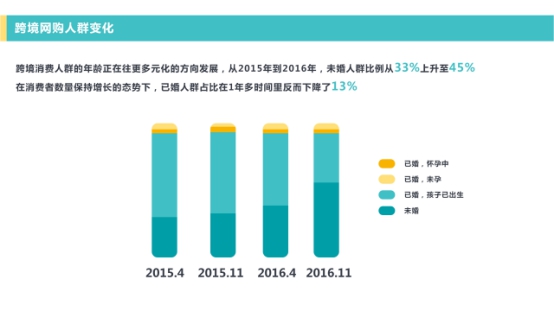
In addition to first-tier cities such as Beijing, Shanghai and Guangzhou, these rapidly increasing young cross-border consumers come from second-tier cities such as Nanjing, Wuhan, Suzhou and Xi'an. In 2015 , the proportion of cross-border consumers in Beijing, Shanghai and Guangzhou has a significant gap with other cities. However, with the emergence of more cross-border consumers in second- and third-tier cities, although the TOP5 is still in first- tier cities, the proportion gap with other more cities has dropped to 2-3 percentage points from more than 13% in 2015 .
In terms of province distribution, this difference is even more obvious. In 2015 , cross-border consumers in the former top three provinces (Zhejiang, Guangzhou, Jiangsu) accounted for more than 50% of the total group , but in 2016 this proportion had dropped to 35% . Provinces in central and western regions such as Hubei, Sichuan, and Henan made rapid efforts.
Three major trends begin to emerge
The emergence of new demands caused by changes in the composition of cross-border consumers has brought three new trends in cross-border consumption in 2016 , namely confidence, personality and professionalism.
The rapid increase in cross-border consumption unmarried people brings new business opportunities to brand owners in the cross-border industry. Compared with dads and dads, current cross-border consumers pay more attention to the current quality of life.
NetEase Kaola HaiPurchase’s self-operated model guarantees the quality of products and after-sales service. Through the formulation of affordable prices, cross-border consumers’ consumer confidence has increased rapidly in the past year.

The proportion of cross-border active consumers trying new overseas products reached 90% in 2016. Compared with the same period in 2015 , sales of cross-border new products increased by 326% year-on-year . Sales of a nanoparticle air purifier from BAD AIR SPONE increased by 48 times within 4 months after its launch .
The rise in consumer confidence will make cross-border brands a good development opportunity for the subsequent brand migration. The increased confidence of cross-border consumers has a wider range of contacts for products, and the definition of personality is also changing.
Unlike the past cross-border trendsetters who pursue fashion brands and luxury goods, today's cross-border consumers pay more attention to reflecting their own personality through the functions and design of the products themselves, and shift their personalities from the preference of gorgeous material desires to more practical emotional comfort.
Digital home appliances, beauty, clothing and snacks and beverages became the new favorites of cross-border consumers in 2016 , and the sales of digital home appliances category increased by 3,600% year-on-year .
Taking digital home appliances as an example, its sales growth rate in 2016 quickly caught up with and exceeded the growth rate of luggage and clothing categories, which are mostly luxury goods. Philips' electric toothbrush, Lingmei's pen, and Acropolis filter kettle have become the new favorites of cross-border consumers in 2016 with their unique functions and design sense . Their sales growth rate is above 400% , reaching a maximum of 1,200% .
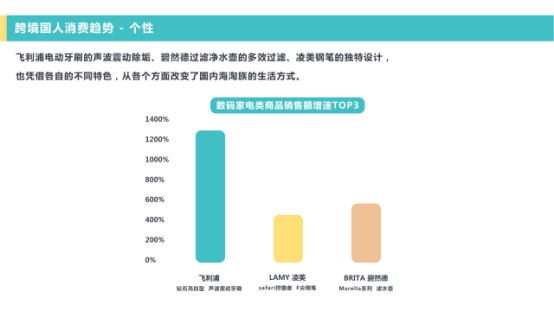
Although consumers in different regions will have different choices of cross-border goods due to the same needs due to different geographical environments, the sense of design, practicality and aesthetics have become the group perception of cross-border consumers' personalized explanations.
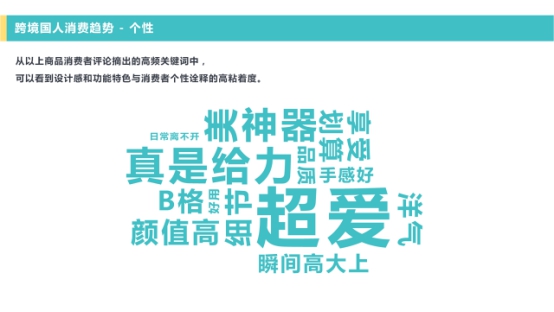
In the personalized cross-border consumption trend, the changes in the purchasing demand of former dads and mothers show another new trend in cross-border consumption - the demand for professional goods is becoming increasingly strong.
While sales growth is rapid, the proportion of sales of diapers and milk powder in maternal and infant categories has decreased by 30% and 29% respectively . However, the sales of baby products increased by 6 times in the six months (second half of 2015 and first half of 2016 ) .
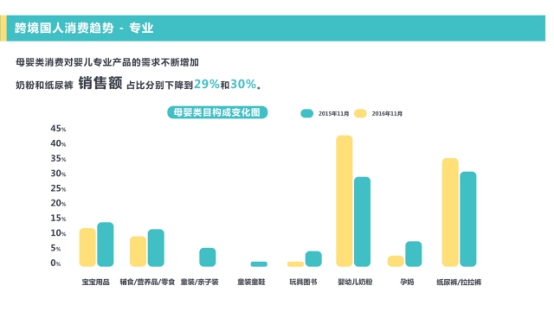
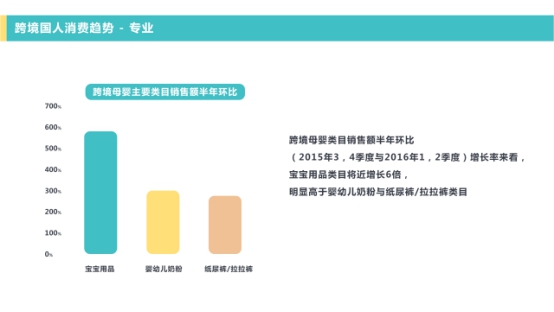
Baoning's children's antibacterial laundry soap and infant laundry detergent, and Ganic Baby's baby tableware foaming cleaner have become new products that nurses compete to buy. While their parenting experience continues to increase, nurses also need more professional products to meet their needs for product choices.
Mobile acceleration synchronization
Through NetEase Koala Ocean Shopping, the daily lives of domestic cross-border consumers have been synchronized globally with overseas consumers.
NetEase Kaola Haigou mobile terminal accounts for nearly 90 %. The mobile shopping trend of domestic cross-border consumers has further strengthened the synchronization of shopping scenarios and living habits.
During the morning rush hour between 7 and 9 o'clock, and during the 8- hour break, whether it is on the lunch table, in front of the desk or on the bed, the needs of cross-border consumers are happening at any time. The mobile shopping experience allows the quality of life of Chinese people to be completely synchronized by the international quality of imported foreign goods.

In white-collar business districts in first-tier cities, afternoon tea time composed of imported food is common; the average transaction time for each order of imported digital home appliances is within 15 minutes, and most of them are within 1-2 hours after lunch ; beauty and makeup are a high-frequency topic for office women. After purchasing good imported goods, they often take them to the workplace the next day to recommend trials for colleagues.
After a year of development, we can see that through NetEase Kaola Ocean Shopping, the lifestyle and consumption concepts of domestic cross-border consumers are synchronizing with overseas consumers, and the speed of synchronizing with overseas consumers is constantly accelerating.
Thank you for your attention and support to Laogao Crown Club . Please indicate the source for reprinting. www.shxuanming.net
